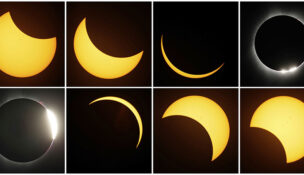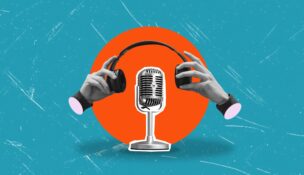A deep dive into the wide world of sports podcasting
Where everybody’s got something to say
Stewart Schley //January 5, 2022//


A deep dive into the wide world of sports podcasting
Where everybody’s got something to say
Stewart Schley //January 5, 2022//
Maybe Andy Warhol had the right idea, but the wrong medium: In the future, it’s not that everyone will be famous for 15 minutes. It’s that everyone will produce a sports podcast.
Start with ESPN: The Disney-owned sports-media giant offers dozens of play-‘em-when-you-want-‘em digital audio shows, racking up, according to ESPN’s press department, a gaudy 499 million downloads last year. That’s just a fraction of the market.
Sports journalist Bill Simmons plants 48 podcasts on his Ringer.com website, mixing hobbyist shows like “Sports Cards Nonsense” (exactly what you think it is) with broader podcasts, like the one where Simmons riffs about HBO Max and the Patriots.
Not to be forgotten (although one can surely wish) Barstool Sports brings its frat-bro sensibility to nearly 100 sports podcasts, ranging from the baseball-themed “Starting9” to “Fore Play” (don’t get all worked up; it’s about golf).
Most of these and other podcasts are available on a variety of venues, including digital audio platforms like Spotify, where you can roam the digital aisles to choose from 2.2 million podcast episodes. We’ll wait.
In Colorado, we’re eardrum-deep in sports podcasts. There are podcasts about the NHL (“Hockey Mountain High” from Mile High Sports), podcasts about football (“Predominantly Orange,” from the eponymous website), podcasts about sports betting (“DNVR Bets” from sports media firm DNVR), and podcasts about fishing (“Terry Wickstrom Outdoors” from KKFN-FM). There are even podcasts underlying podcasts. On iHeartMedia’s KOA-AM, Broncos lineman Shelby Harris hosts “Shel-Shocked,” one of four KOA podcasts devoted entirely to the Denver Broncos, because: Broncos.
Podcasts are self-contained audio experiences (the “pod” element), most of which are – and this is the important part – available to listen to whenever you want. “If you go to lunch at 12:17 and you want to listen to ‘The Avalanche Podcast’ at 12:17, guess what? You can.” That’s Brandon Spano, CEO of DNVR Media, sharing one reason he thinks podcasts someday will become the dominant form of audio entertainment, leapfrogging even live radio.
That sort of heady optimism is one reason companies keep firing up microphones and licensing the intro music despite a crowded field of play. In October, when sports radio station KKFN launched a postgame podcast devoted to the Colorado Avalanche, the idea was to “super-serve” fans who can’t get enough of the team. Program director Raj Sharan’s belief is that “the most successful podcasts are hyper-focused, with a really specific audience target.”
This fine-grained focus, though, adds up to lots of podcasts. Which means a lot of opportunities to not make very much money.
Former ESPN boss Jon Skipper summed up the state of affairs in a Bloomberg interview in September. “I sometimes say the last refuge of every journalism scoundrel is they’ll announce they’re doing a podcast,” said Skipper, now a partner in a sports media company called Meadowlark Media, which is scouting talent for…wait for it…sports podcasts. Skipper points out that if you take the entire amount of money advertisers spend nationally on podcasts (roughly $1.5 billion annually) and divide it by the number of podcasts being produced (millions), the revenue average comes to something like $2 per hour.
Obviously, there are standouts that defy the rule. Still, because of the sheer tonnage, it’s not a medium for the faint of heart, or the light of bank account. Spano, whose media company recently expanded into the Phoenix market with a combination of live and on-demand video and audio podcast content, points out the sprawl of sports podcasts makes it difficult for anybody to break into the market from ground zero. Instead, he thinks podcasts work best to supplement an existing media business. “You have to have an audience first,” Spano says.
His reasoning aligns with the thinking at KKFN. Although Sharan’s main focus is putting on a live broadcast, he believes KKFN’s podcasts work nicely to extend the reach of the KKFN brand outside of the normal radio environment. Same for Mile High Sports, where CEO Nate Lundy, who also prizes podcasts for their ability to zero in on granular topics, says “having as many tentacles out in the public as possible gives you the best chance for success.”
For fans, the sports podcasting revolution is, as the kids say, all good. Fans have more choices than ever to hear first-hand from players, owners, journalists, other fans, even referees. Plus, there’s a human dimension: There’s something inescapably appealing about hearing a person’s high-resolution voice whooshing pleasantly into your earbuds. (If you doubt that, check out the odd but growing field of podcasts devoted to “autonomous sensory meridian response,” or ASMR. You’re welcome.)
That leaves podcasts in an interesting position vis-à-vis the sports-media ecosystem. They’re great for listeners and good for brand-building. When it comes to making money, however, podcasts look a bit like the utility shortstop on a minor league ballclub: Full of hope, but at least for the moment, short on cash.
Stewart Schley writes about sports, media and technology from Denver. Read this and Schley’s past columns on the web at cobizmag.com and email him at [email protected].






















